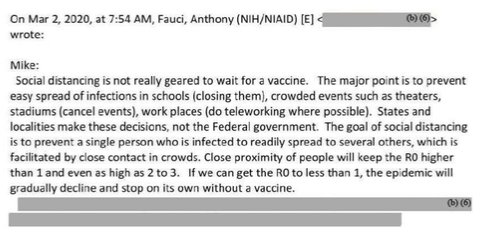The email dump of Dr. Anthony Fauci’s correspondence is a treasure trove of insight. Don’t rely on the major media to explain what’s in it, however. Reporters hardly have time to dig through thousands of pages, so they become echo chambers of what others are saying. I’ve gone through most, not all, but I’m most interested in the material from March 2020. Here is where we find out what Fauci was thinking before the American people were greeted with lockdown shock and awe.
I draw your attention to an exchange from March 2, 2020. Hysteria was already in the air. The New York Times was fueling it. Other media joined in. We were two weeks away from lockdowns. There was a tremendous amount of public speculation that quarantines were coming but not a single event had yet been cancelled. The cancellation of South by Southwest by the Austin, Texas, mayor was still a week away.
Media were attempting to coordinate messaging with the federal government (and you thought we had a free press!). Michael Gerson from the Washington Post sent Fauci a column to make sure that Fauci approved.
Gerson asked Fauci the following: “Is the overall strategy of social distancing just to keep the percentage of Americans who get the disease low until a vaccine is available? This seems much harder to do in a free society. Does this mean closing schools? Public transport? Do states and localities make such decisions?”
Fauci’s answer is surprising. No, he said, that’s not the point. The point is to suppress the disease so that it goes away. Not one word about “flatten the curve” to preserve hospital capacity. Fauci even says that with enough forced human separation, the virus can be made to “decline and stop on its own without a vaccine.”
Again, it wasn’t just Donald Trump who believed the virus would vanish. Fauci held this view too, provided that he was put in charge of all human association from sea to shining sea.
Here is the actual text from Fauci, major parts of which ended up word-for-word in Gerson’s column that week.
“Social distancing is not really geared to wait for a vaccine,” wrote Fauci. “The major point is to prevent easy spread of infections in schools (closing them), crowded events such as theaters, stadiums (cancel events), work places (do teleworking where possible…. The goal of social distancing is to prevent a single person who is infected to readily spread to several others, which is facilitated by close contact in crowds. Close proximity of people will keep the R0 higher than 1 and even as high as 2 to 3. If we can get the R0 to less than 1, the epidemic will gradually decline and stop on its own without a vaccine.”


There are several reasons why this is shocking. 1) Gerson was allowing Fauci to write his column, 2) the plan to lock down was already in the works two weeks before they came about, 3) there is no mention of preserving hospital capacity; that propaganda line was yet to be invented to justify lockdowns, 4) Fauci didn’t really believe that we needed a vaccine to make the pandemic end, and 5) Fauci is thoroughly messed up in his understanding of the R0 (or R Naught, which is a fancy way of saying the infection rate).
We need to unpack point number 5 really to understand. The R Naught is not as complicated as it sounds. If you get infected and pass the virus on to one person, and him to one person, and that person to another person, and this pattern persists throughout society, you have an infection rate of 1. If you pass it on to two people, and on down the line, you have an R Naught of 2. And so on it goes. If it falls below one and finally to 0, the pandemic qualifies as endemic.
The infection rate is always conjectural, not really empirical. It’s impossible to discern without universalized, random, and thoroughly accurate testing, tracing, and tracking. Those conditions have never been met in any country or any pandemic. So what seems to be a measure of an existing reality is really true only in theory, not realistically discernible in the midst of a pandemic. At best, it is an estimate.
The problem gets worse. (By the way, I’m grateful to the many scientists and epidemiologists who have explained this to me.) If the R Naught signifies anything it is an ex post description of conditions on the ground. It is not a causative agent; it is merely descriptive. For example, if I tell you that most drivers now have their windshield wipers on, you would be rational to conclude it is raining. The measure of wipers is an indicator, not a force that makes rain come or go.
What Fauci has done here (and this is consistent with what many of these disease models have done) is mixed up a cause with an effect. Fauci’s idea is to drive the infection rate to 0. This would suggest that the virus cannot find a host (not that viruses are volitional). The R Naught in principle reveals what a virus is doing but it does not actually cause the virus to behave in a certain way. It’s the equivalent of ordering drivers to turn on wipers to make the rain come down, or forcing people to put away umbrellas to make it stop.
Think of this in economic terms. When you have inflation, prices are being pushed up due to increases in the money supply (holding all other factors constant). The cause is the money supply increases; the effect is the rise in prices. If you are a fool – and many government economists are – you might try to control the inflation rate by stopping the price increases with, for example, price controls. To be sure, many “experts” have tried to do this but it has never worked. It does not work because it is an attempt to game the effect without dealing with the cause.
So it is with the infection rate. It is not possible simply to push down the infection rate through a far-flung theory that viruses only spread in crowds. Even if you could do so, the virus is still there, and the instant people get together again (if the theory of spread holds) the infection rate will shoot up again. Again, the economic analogy holds: repeal the price control and prices shoot up simply because you have failed to deal with the underlying problem of excessive money printing.
I must say that I have suspected that this confusion was present all along. I thought so last summer when I kept hearing about the need to reduce the infection rate via shutdowns, lockdowns, closures, and so on. The belief that this is effective is completely confused. Even if it worked for a time, the effects are not sticky because there is not enough immunity in the population (“herd immunity”) to make the virus less threatening. No pandemic of a new virus like SARS-CoV-2 has ever found its endemic equilibrium without sufficient immunity in the population gained either through natural infection or vaccines. Such a virus cannot be tricked by powerful scientists bearing computer models.
The Fauci theory of “social distancing” as it stood on March 2, 2020, was literally an impossibility, despite his air of certitude. It would absolutely have required mandatory human separation either forever or until there was a vaccine. Forget two weeks to flatten the curve; it was always intended to be more draconian. As Gerson himself suggests, this surely cannot work in a “free society.” Of course we know that such words do not register with Fauci: “I don’t look at this as a liberty thing,” he told Rep. Jim Jordan a full year later.
It’s long past time for the pandemic central planners to level with the American people about what they were attempting and why. They did not explain then, and they have yet to explain to this day. It’s too bad we have to find out just how harebrained their theory was via an email dump. But such is the way public policy is in America today: powerful fanatics trying out untested and far-flung theories on a public that is rightly and increasingly skeptical that any of these people have a clue.
Join the conversation:


Published under a Creative Commons Attribution 4.0 International License
For reprints, please set the canonical link back to the original Brownstone Institute Article and Author.









